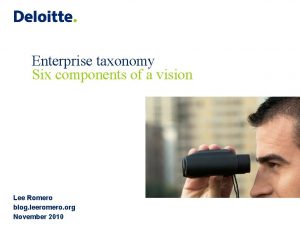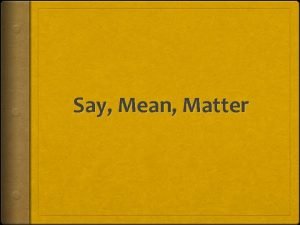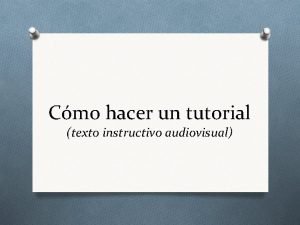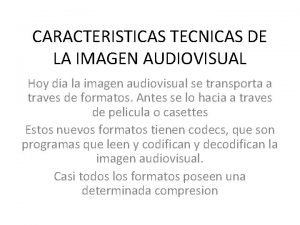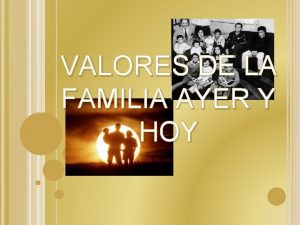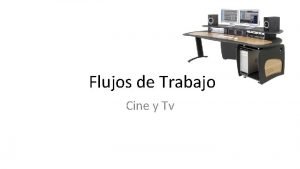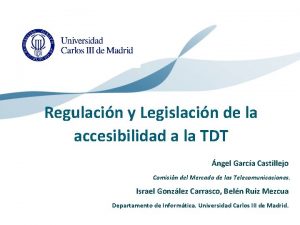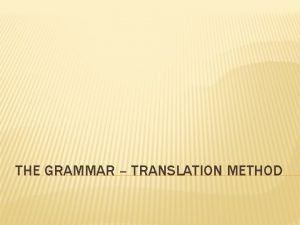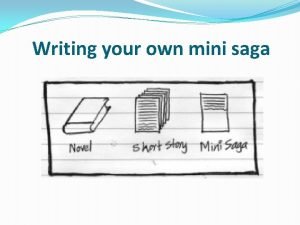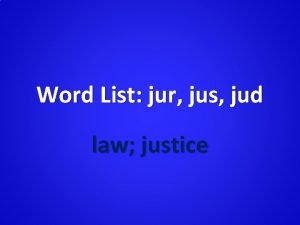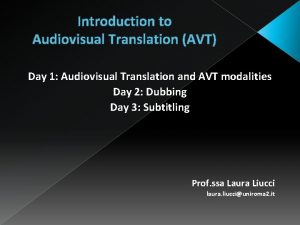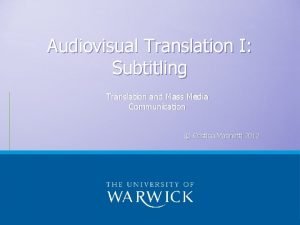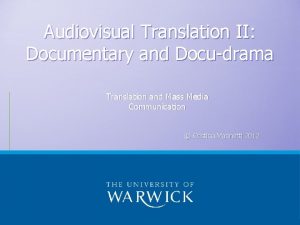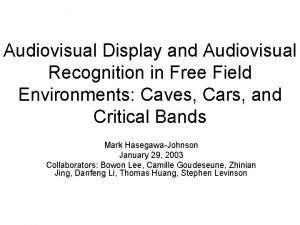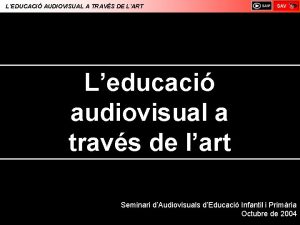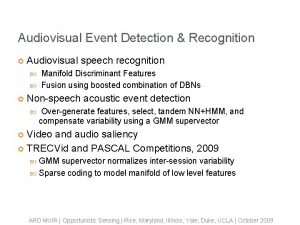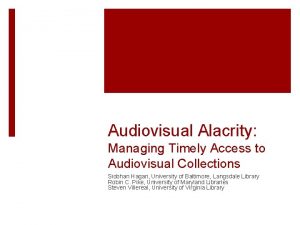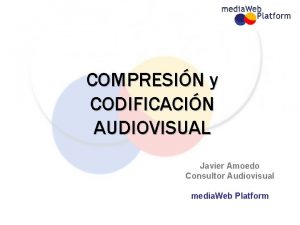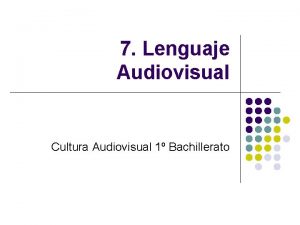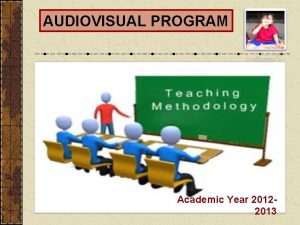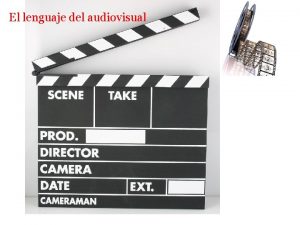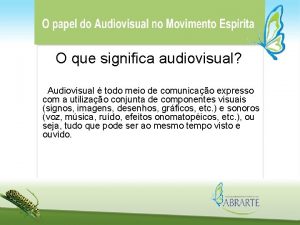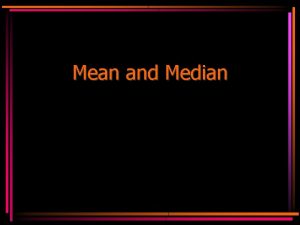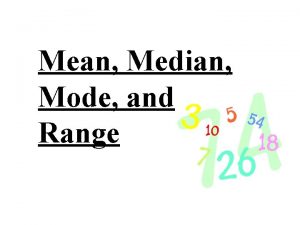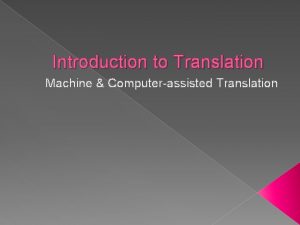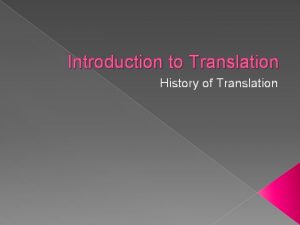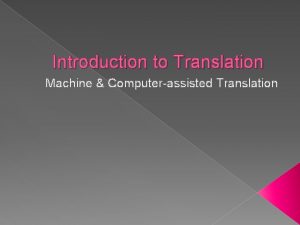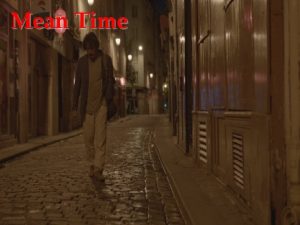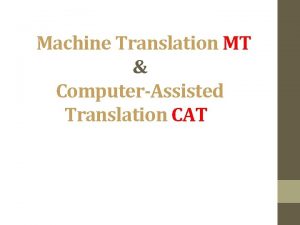Audiovisual Translation Introduction WHAT DOES IT MEAN Translation




























- Slides: 28

Audiovisual Translation (Introduction)

WHAT DOES IT MEAN?

Translation • approaches to translation: • source versus target oriented • linguistic, functional, cultural studies-oriented, cognitive, philosophical • examples of issues: • equivalence, e. g. formal versus dynamic • strategies to be adopted, e. g. domesticating versus foreignising • textual features such as deixis, presupposition, lexical choice, modality, politeness markers • ideology 3

Translation (cont’d) • • • audience design translation and publication patterns in the world translation and (post) colonialism translation and gender universals of translation 4

Types of audiovisual translation • Inter-lingual translation • subtitling • dubbing • voice-over • Intra-lingual (monolingual) subtitling for the hard-of-hearing and the deaf • Audio description for the blind • Live subtitling (e. g. news broadcasts) • Subtitling for opera and theatre 5

Subtitling, dubbing, or voice-over? Subtitling • advantages: not expensive, does not take a very long time, original soundtrack is preserved, may have a role in language learning, is better for the hard-of-hearing and the deaf and for immigrants and tourists • disadvantages: ‘contaminates’ the image, greater loss of information due to compression, the attention of the audience is split between image, soundtrack, and subtitles Note: oral text written text 6

Subtitling, dubbing, or voice-over? Dubbing • advantages: does not distract attention from image, is better for children and for people with poor reading skills, less reduction of the original dialogue compared to subtitling • disadvantages: expensive, takes more time, loss of the original soundtrack, the voices of dubbing actors can become repetitive after a while Note: oral text 7

Subtitling, dubbing, or voice-over? Voice-over • advantages: not expensive, does not take a long time to make, may be appropriate to some audio-visual genres (such as documentaries, particularly when it comes to translating the narrator’s part) • disadvantages: it ‘contaminates’ the original soundtrack, if used in genres such as feature films it may create confusion as to who is speaking 8

Subtitling for the hard-of-hearing • indicate relevant noises in your subtitles (music, phone or doorbell ringing, footsteps, shouting). Otherwise, scenes may become incomprehensible • make it easier to understand who is speaking (especially if off-screen): use colour codes and/or change the position of the subtitles • avoid paraphrase; use as many of the ST words as possible (unlike in interlingual subtitling!) • take into consideration the issue of reading speeds 9

Audio description for the blind • the ‘usual’ soundtrack is not enough to understand what is going on in the programme • but why does someone blind need to ‘watch’ TV? Can’t they listen to the radio instead? Issues of social integration and access to information • different views on how to best do audio-descriptions • the skills of an audio-describer 10

AV translation and language policy • the right of linguistic and/or ethnic minorities to have access to audio-visual programmes in their own language; • the role of nationalism in decisions with respect to form of audio-visual translation; • the right of the hard-of-hearing and the deaf to have access to audio-visual programmes; • the role of screen translation in language acquisition. 11

Subtitling Leeds, 6 May 2004 Intro to Audiovisual Translation Serban A. 12

Main issues involved in subtitling • linguistic, cultural, and cognitive issues involved in subtitling • spoken versus written language • the audience • time/space constraints in subtitling text compression 13

Linguistic issues involved in subtitling • transfer from spoken to written text • cohesion • swear words and slang • dialects and accents • broken language • use of several languages in the audio-visual programme • etc 14

Cultural issues • cultural references • intertextuality • cross-cultural politeness • humour • etc 15

Cognitive issues • reading speed • efficiency (processing ease), effectiveness (processing depth) and appropriacy (correlation between text, current occasion, and receivers). • considerations of relevance (see Sperber and Wilson 1986) Note: the importance, for the audience, of experiencing the audio-visual programme in a holistic way 16

Time/space constraints Text compression Constraints • time constraints: a minimum of 1. 5 to 2 seconds display per chunk of subtitles, and a maximum display of 6. 5 to 7 seconds • space constraints: not more than two lines per screen, and not more than 34 -37 characters/line • rhythm • cuts 17

Text compression (cont’d) Text compression • the original may need to be reduced with as much as 1/3 (e. g. fast speakers, several people speaking at the same time, programmes where it is felt that the audience should be left to focus on the image) • involves reformulation, summarisation, adaptation • simplification of syntax So, how do you decide what to leave out? Examples: false starts, interjections, (some) repetitions, (some) interpersonal markers 18

Child audiences • what is a child audience? • books versus audiovisual programmes • prevalent ideas about childhood • adults creating programmes for children • the role of programmes for children • controversies and censorship • parents will often watch with children, hence there are two very different audiences at the same time. So, frequently, there is double-coding • dubbing is preferred 19

Voice-over and Audio Dubbing What you need to know • Context of the video: it is very important that the client specifies the context in which the video will be used and its target audiences in order for us to select the appropriate translators and voice talents. • Receiving the scripts and translating: Once we receive the scripts or have transcribed the video ourselves, we proceed with translation + revision by a second independent translator and send for client’s approval. • Adequate Voice Talents: Oncethetranslationis completed, we proceedwiththerecordingof thevoices. In both cases, for dubbing and voice-overs, the client can choose the type of voice that should be used in the videos (male or female, younger or older, children, soft and tender voice, accent, etc. ). We can also propose to try matching the tonality of the English voice (or whichever language the source video is in). • Good to know! We will send the client samples of voice talents, usually a choice of three for every voice in the video/audio, and a short description to why those voices selectedare good and suitable. • Is lip syncingrequired? Do we need to make sure that we match the lip movement onscreen with the voice? • In most cases, our clients settle for syncingonthesentencelevel(phrase-syncdubbing)as 100% lip sync is very expensive andit also requires a lot of studio time to get it right. Usually the aim is just to match the visuals or talking heads. @conversis_uk

Voice-over and Audio Dubbing What you need to know • Checkingthe source script: We always check with the client if we have doubts about any terms that might be problematic to pronounce (especially English words that are not translated) and we clarify the pronunciation of brand names both with the client and with the voice talent. • For ambiguousterms/possible issues around pronunciation, a call involving the voice artist, sound engineerand the personresponsible for approving the video might help. • During the recordingsession: We always recommend that a linguistic director (who ideally would have also done the translation) is present at the recording, as he/she is capable of directing the voice talent and sound engineer on tone of voice, accent, pronunciation, etc. , based on the brief received from the client. The client can also be present at the recording session or call the studio and listen to the recording live to make suggestions. @conversis_uk

Voice-over and Audio Dubbing What you need to know • Usage. Fee? We need to consider what the usage of the recording will be. If it is for restricted online use then there are no usage fees. If it will be in public use online or via TV or other public broadcast then a usage fee is typically charged. • Qualitychecks: For voice-over/dubbing it is very important that the translation of the script is approved by the client prior to the recording session. Any matters on pronunciation (brand, product names, etc. ) will also need to be clarified. This is important as having to reorganise a session will be expensive, including additional studio and talent fees. Therefore we always recommend that the client dials-in or attends the recording session. For any uncertainties we can alwaysproduce additional takes for the client to select from but re-recording will always add time/costs to the project. @conversis_uk

Voice-over and Audio Dubbing What you need to know • Charges involvingvoice-overs and dubbing: • Translation and Revision of the scripts/transcription (if required) • Voice talent • Studio Facilities: Studio time required to prepare for recording, record, edit and mix in order to create the final files • Voice-over Director • Project Management @conversis_uk

Mendayung sampan ke tepian Bersama Kekasih. .

Sekian dan Terimakasih


Terimakasih…. . Untuk mahasiswa/i yang tidak ngantuk dan tetap konsentrasi Mengikuti Perkuliahan. Sampai berjumpa minggu depan ……. . (Dalam perkuliahan dosen yang sama)

Terimakasih • http: //process. spoken-tutorial. org/index. php/Dubbing_Stages 28
 Calculate mean absolute deviation
Calculate mean absolute deviation What does mean mean
What does mean mean Say mean matter chart
Say mean matter chart Definicion de lenguaje audiovisual
Definicion de lenguaje audiovisual Ejemplo de texto instructivo audiovisual
Ejemplo de texto instructivo audiovisual Caracteristicas de la imagen audiovisual
Caracteristicas de la imagen audiovisual The audiovisual tuesdays with morrie
The audiovisual tuesdays with morrie Postal audiovisual
Postal audiovisual International standard audiovisual number
International standard audiovisual number Education audiovisual and culture executive agency eacea
Education audiovisual and culture executive agency eacea Los valores de ayer y hoy
Los valores de ayer y hoy Flujo de trabajo audiovisual
Flujo de trabajo audiovisual Ley comunicacion audiovisual
Ley comunicacion audiovisual Communicative meaning in semantics
Communicative meaning in semantics Cisco voice translation-rule
Cisco voice translation-rule Transformation of functions
Transformation of functions Semantic translation và communicative translation
Semantic translation và communicative translation Sample mean and population mean
Sample mean and population mean Difference between mean and sample mean
Difference between mean and sample mean How to compute population mean
How to compute population mean Mean of the sampling distribution of the sample mean
Mean of the sampling distribution of the sample mean Define mean deviation
Define mean deviation Grammar translation
Grammar translation The grammar translation method شرح
The grammar translation method شرح Where does translation take place
Where does translation take place How to write mini saga
How to write mini saga Dissecting the prompt
Dissecting the prompt Jur jus jud root word list
Jur jus jud root word list What does wide qrs mean
What does wide qrs mean

